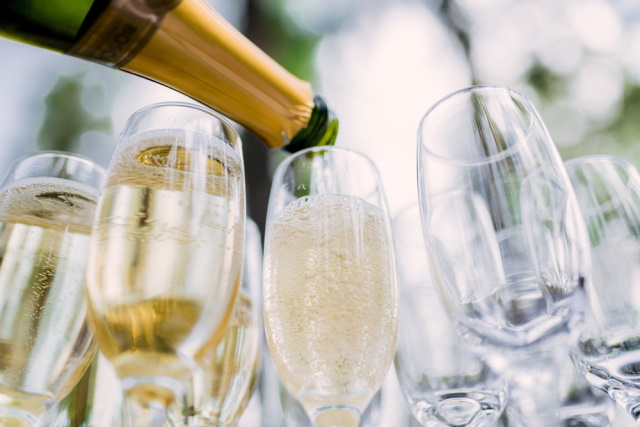
Whether you're a professional sommelier or a self-taught wine expert looking to build an impressive collection, you probably know where all of the best wines come from. Italy, of course, makes the list of top wine-producing countries, along with France, Spain, and the United States. Because a significant amount of the world's wine is produced in these areas, it's easy to forget that plenty of other countries are taking on the task of crafting bottles of delicious wine, too...including England.
No, England is not historically a wine-producing country, but in recent years, the country has begun to up its wine game and follow in the footsteps of its wine-producing neighbors, France and Spain. As of 2021, there are more than 400 commercially active vineyards in England. The majority of these are located in the southeastern portion of the country on land with soil similar to that of France's Champagne wine region. Thanks to the similarity of soil, the English vignerons can craft a sparkling wine that's a lot like champagne.
In this article, we'll take a closer look at England's approach to the art of wine-making, dive into similarities and differences between English sparkling wine and French champagne, and help you decide whether a bottle of this bubbly should be the next addition to your growing wine collection.
The History of English Wine-Making
Despite being relatively new players in the wine-producing industry, the English have enjoyed wine for centuries. Many believe the Romans brought the first vineyards to the country before the Middle Ages, but it wasn't until 1066 that the concept of successful wine-making became a reality in England. The existence of more than 40 vineyards was recorded during that time.
With the Middle Ages came an expansion of wine production, but the declining climate led to a decrease in vineyards. Wine-making in the country did not die out entirely, however, efforts to bottle were reduced to small-scale experiments on private properties. Experimenting on one's own land would continue throughout the 19th century, and commercial grape growing wouldn't take off until the second half of the 20th century.
Ray Barrington Brock would become a pioneer of the English wine-making world in 1946, when he set out to discover the grape varieties that were most suitable for growing in the British climate. A handful of growers followed his lead and suggestions, planting his findings on their properties and discovering that he was onto something.
From there, English wine production only continued to grow. The English Vineyards Association was established in 1968 and boasted about 83 members in its first year. By the mid-1990s, however, there would be over 400 vineyards in England and the United Kingdom, with numbers expected to continue increasing in the 21st century.
Meet English Sparkling Wine
Of the wines the country has managed to produce since the mid-20th century, English sparkling wine is probably the most popular, thanks to the location and soil type of the vineyards. You'll find these bottles being made mostly in the southern portions of the country in Kent, Sussex, Hampshire, Dorset, and Cornwall. These regions make the perfect location for champagne-like grapes, complete with mineral-filled soil and an ideal altitude.
Unfortunately, despite having lovely growing conditions, vignerons still have to fight against England's ever-changing weather. For example, the cold and wet summer of 2012 made wine production a challenge, and area growers struggled to produce a worthwhile quantity of wine.
Six years later in 2018, however, the circumstances were completely different, and a long, hot summer led to wine producers with more bottles of bubbly than they had storage for. Because the weather in England is so unpredictable, each vintage is extremely varied.
English Sparkling Wine vs. Champagne
As of 2019, sparkling wine accounted for a whopping 69 percent of the production — that's approximately 10.8 million bottles — produced in England and Wales. Those statistics are proof enough that people enjoy English sparkling wines. But the question remains: can these bubbly bottles compete with Champagne?
Before you can decide which is better, you should know a bit more information about the two. Both English sparkling wine and Champagne are made from the same varieties of grapes — Chardonnay, Pinot Noir, and Pinot Meunier — and are produced the same way.
Both English and French wine producers begin with fermentation in a tank, follow with the addition of sugar syrups and yeasts, go on to the secondary fermentation in a bottle, then allow the product to age before disgorgement, the addition of the dosage, and a final aging period. They even taste somewhat similar with a clean palate and high acidity.
The most significant differences between the two are the fact that Champagne production has gone on much longer, beginning hundreds of years before that of English sparkling wine, and though they taste similar, English wines are known for having a fresh, apple-like crunchiness.
Ultimately, the winner of the battle of wines depends entirely on your personal preferences, but either beverage works just fine for making a celebratory toast, ushering in a new year, or as refreshment at your next soiree. If you're interested in conducting an at-home taste test, find a reputable retailer of English sparkling wines, order a bottle of your favorite Champagne or sparkling wine from J.J. Buckley Fine Wines, pour yourself a glass of each, and decide for yourself which best suits your taste buds.
If you're unsure which champagne to use for your taste test, enlist the aid of one of J.J. Buckley's wine specialists. We are wine experts dedicated to helping you find a great bottle. We can make recommendations based on your preferences, answer all of your questions on pairings and tasting notes, and give you offers on the world's best wines that you won't find anywhere else.